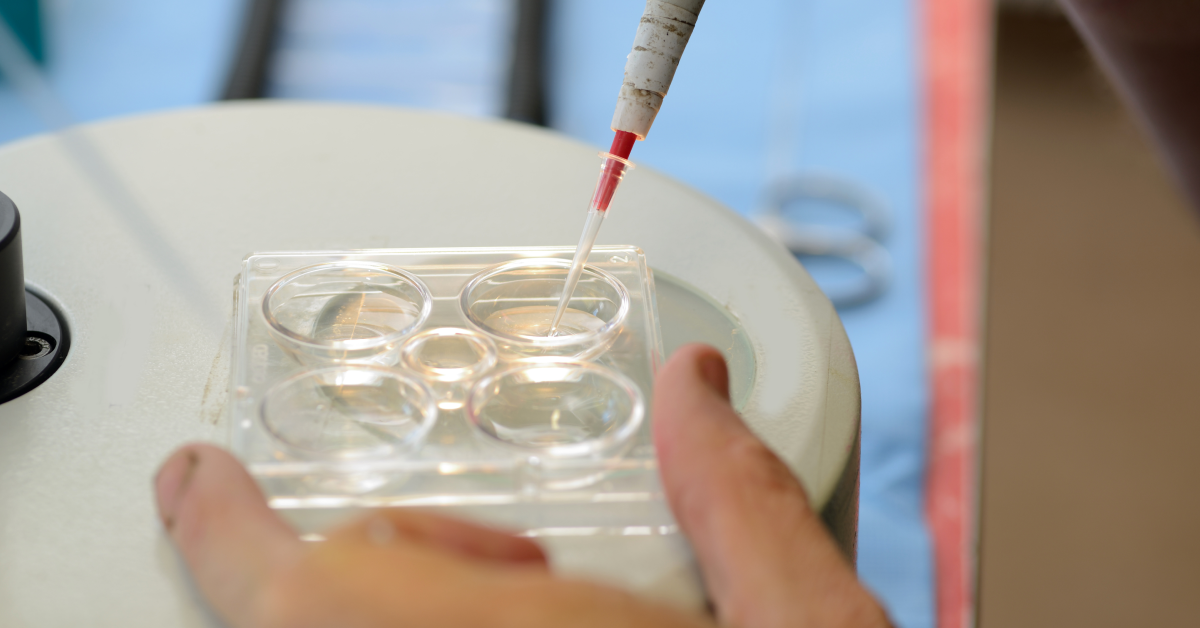Improving the success rate of Embryo Transfer (ET) is a significant issue in cow breeding. Technological breakthroughs are revolutionizing how breeders manage and maximize their operations, and software solutions are helping livestock farmers increase their Embryo transfer success rates in cattle.
What is Embryo Transfer in Cattle?
Embryo transfer in cattle is a state-of-the-art reproductive method breeders can use to multiply the number of progeny from valuable cows. In this procedure, fertilized embryos are removed from a donor cow and inserted into recipient cows. Embryo transfer in cattle increases the number of offspring from elite genetics and considerably accelerates genetic progress.
Why Embryo Transfer Matters?
Embryo transfer in cattle encourages breeders to harness their herds’ full genetic potential, increasing productivity and profitability. Additionally, it aids in preserving valuable genetics, which is crucial for conserving rare breeds and enhancing livestock quality.
Innovative Techniques and Methods to Maximise Success Rates in Embryo Transfer in Cattle
The cornerstone of genetic advancement in cattle lies in the efficient and successful implementation of embryo transfer in cattle technology. While this process offers immense potential for herd improvement, suboptimal success rates often hinder it.
A paradigm shift is imperative to unlock ET’s full potential and propel the cattle industry forward. This necessitates comprehensively exploring innovative techniques and methodologies to maximize embryo viability, implantation, and subsequent calf development.
Below are the innovative techniques and methods that can significantly elevate embryo transfer in cattle success rates, thereby contributing to a more productive and sustainable cattle industry:
1. Hormonal Stimulation
A key aspect of embryo transfer in cattle is superovulation, where a donor cow is stimulated with hormones to produce multiple eggs. These eggs are then fertilized and collected for transfer. Precision in hormone administration is vital, and software tools play a significant role in tracking and optimizing these treatments.
2. Harvesting and Assessing Embryos
After collection, embryos are evaluated and graded based on quality before being transferred to recipient cows. Software systems streamline data management related to embryo quality, donor and recipient health, and timing, ensuring optimal pairing and higher success rates.
3. Embryo Culture and Vitrification
Optimizing embryo culture conditions is crucial for their development. Advances in culture media and environmental control have significantly improved embryo viability. Vitrification, a rapid freezing technique, allows for long-term embryo storage and transportation without compromising quality.
4. Recipient Selection and Preparation
The recipient cow’s uterine environment plays a pivotal role in embryo implantation. Careful selection of recipients based on reproductive history, body condition, and health status is essential. Synchronizing the recipient’s estrous cycle with the embryo development stage is critical.
5. Embryo Transfer Techniques and Timing
The method of Embryo transfer in cattle, whether surgically or nonsurgically, can impact success rates. Minimizing stress on the embryo during the transfer process is crucial. The precise timing of the embryo transfer about the recipient’s estrous cycle is vital for successful implantation.
6. Post-Transfer Care and Management
Providing optimal care for recipient cows during the early stages of pregnancy is essential. Proper nutrition, health monitoring, and stress management contribute to successful pregnancies.
7. Data Management and Analysis
Comprehensive data collection and analysis are essential for identifying trends, optimizing protocols, and improving overall ET efficiency. Software-based tools enable efficient data management and provide valuable insights.
The Embryo Transfer Process

Embryo transfer (ET) is a complex reproductive technology propagating desirable animal genetic traits. The process involves several intricate steps:
Donor Selection and Preparation
- Donor Identification: High-performing females with superior genetic characteristics, such as milk production, growth rate, or disease resistance, are carefully selected as donors.
- Synchronization: Donor females are brought into synchronized estrus to optimize egg production and timing for subsequent procedures.
- Superovulation: Donors are administered hormonal treatments to stimulate the development of multiple follicles and produce a more significant number of eggs.
Egg Retrieval and Fertilization
- Ovulation Induction: Hormonal treatments are refined to induce final maturation of the follicles and time the precise moment for egg retrieval.
- Egg Collection: Mature eggs are retrieved using ultrasound-guided aspiration, a minimally invasive procedure.
- In Vitro Fertilization (IVF): Collected eggs are fertilized with high-quality sperm in a controlled laboratory environment.
Embryo Development and Transfer
- Embryo Culture: Fertilized eggs (zygotes) are incubated under specific conditions to allow them to develop into early-stage embryos.
- Embryo Evaluation: Embryos are assessed for viability and developmental stage before transfer.
- Recipient Selection: Healthy females with suitable reproductive tracts are chosen as recipients for embryo transfer.
- Embryo Transfer: Viable embryos are carefully deposited into the uterus of recipient females using specialized techniques.
Pregnancy Monitoring and Calf Production
- Pregnancy Diagnosis: Recipients are monitored for pregnancy using ultrasound or hormone tests.
- Pregnancy Management: Proper nutrition, healthcare, and environmental conditions are provided to support successful pregnancies.
- Calf Birth and Rearing: Calves born from transferred embryos are cared for according to standard husbandry practices.
What’s the Difference Between Traditional and Software-Enhanced ET Methodologies of Embryo Transfer in Cattle?
The evolution of technology has permeated nearly every sector, and animal reproduction is no exception. Embryo transfer in cattle is a cornerstone of genetic advancement, and it has also undergone a significant transformation with the integration of software-based tools.
Let’s delve into a comparative analysis of traditional and software-enhanced ET methodologies:
Data Accuracy and Efficiency
- Traditional ET: Manual record-keeping is time-consuming and prone to human error, potentially impacting decision-making.
- Software-Enhanced ET: Automated data collection and analysis ensure accuracy and efficiency, allowing for real-time monitoring and intervention.
Predictive Analytics
- Traditional ET: Identifying optimal timing for embryo transfer and recipient selection is primarily based on experience and intuition.
- Software-Enhanced ET: Advanced algorithms analyze historical data to predict optimal conditions, increasing the likelihood of successful embryo implantation.
Decision Support
- Traditional ET: Decision-making often relies on limited information and expert opinion.
- Software-Enhanced ET: Data-driven insights provide valuable recommendations, empowering practitioners to make informed choices.
Key Differences
| Feature | Traditional ET | Software-Enhanced ET |
| Data Management | Manual | Automated |
| Decision Making | Experience-based | Data-driven |
| Predictive Capabilities | Limited | Advanced |
| Efficiency | Lower | Higher |
| Accuracy | Lower | Higher |
How Folio3 Agtech Software Helped in Vytelle’s Success? – Case Study
Vytelle, a company specializing in cattle breeding, implemented a software solution to manage its ET program. The software tracked estrous cycles, monitored cow health, and provided detailed analytics on embryo quality. As a result, their success rate in embryo transfers increased by 30%, and overall herd quality improved significantly.
What are the Key Metrics in Embryo Transfer in Cattle?
Tracking key metrics is essential for evaluating the efficiency and profitability of an embryo transfer (ET) program. These metrics provide valuable insights into areas for improvement and help optimize the overall process. Here’s what you need to watch:
Core Metrics
- Embryo Recovery Rate: The number of embryos recovered per donor cow.
- Embryo Survival Rate: The percentage of embryos that survive the freezing and thawing.
- Pregnancy Rate: The percentage of recipient cows that become pregnant after embryo transfer.
- Calving Rate: The percentage of pregnant cows that successfully deliver calves.
- Twin and Triplet Rates: The frequency of multiple births that can impact profitability and management.
- Sex Ratio: The proportion of male and female calves born.
- Cost per Calf Born: The total cost of producing a calf through ET.
Additional Metrics
- Embryo Quality: The assessment of embryo morphology and developmental stage.
- Recipient Pregnancy Loss: The percentage of pregnancies that are lost before calving.
- Calf Birth Weight: An indicator of calf health and potential future performance.
- Calf Mortality Rate: The percentage of calves that die within a specific period.
- Return on Investment (ROI): A measure of the financial profitability of the ET program.
Considerations
- Data Collection: Accurate and consistent data collection is crucial for meaningful analysis.
- Benchmarking: Comparing performance to industry standards or other herds can identify areas for improvement.
- Data Analysis: Utilizing statistical methods to analyze metrics can uncover trends and correlations.
The Importance of Genetic Progress in Cattle Breeding
Genetic progress is the cornerstone of a thriving cattle industry. It improves traits such as milk production, meat quality, fertility, disease resistance, and overall animal health.
Producers can enhance herd productivity, profitability, and sustainability by selecting and breeding animals with superior genetic makeup.
The Role of Embryo Transfer (ET) in Accelerating Genetic Progress
Embryo transfer in cattle is a powerful tool for accelerating genetic progress. It allows for the rapid multiplication of superior genetics by transferring multiple embryos from a high-performing donor cow to multiple recipient cows. This process significantly increases the number of offspring from elite animals compared to traditional breeding methods.
Folio3 Agtech Software for Enhanced Donor and Recipient Selection
Folio3 Agtech Software is crucial in optimizing ET programs by facilitating better selection and pairing of donor and recipient cows. These tools analyze vast amounts of data, including:
- Genetic evaluations: Identifying animals with superior genetic merit for specific traits.
- Reproductive performance: Assessing historical data on fertility, calving ease, and milk production.
- Health records: Identifying animals with a strong health history.
- Physical attributes: Evaluating body conformation, size, and other relevant traits.
By using this information, software tools can:
- Identify optimal donor cows: Select animals with exceptional genetic potential and proven reproductive performance.
- Match donors and recipients: Pair animals based on compatibility factors such as genetic makeup, body condition, and reproductive status.
- Predict embryo viability: Assess embryo quality and development potential to maximize transfer success.
- Optimize resource allocation: Efficiently manage donor and recipient herds by identifying the most productive animals.
- Monitor program performance: Track key metrics and identify areas for improvement.
How Software Revolutionizes Cattle Breeding?
Integrating software into cattle breeding has ushered in a new era of precision and efficiency. By automating data collection, analysis, and decision-making, breeding software empowers producers to optimize their operations and maximize genetic progress.
Specific Features of Breeding Software
- Cycle Tracking: This feature meticulously records donor and recipient cows’ estrous cycles, insemination dates, and pregnancy statuses. Producers can optimize timing for embryo collection, transfer, and synchronization by accurately monitoring these cycles, thereby increasing the chances of successful pregnancies.
- Health Monitoring: Breeding software provides comprehensive health recordkeeping, including vaccination schedules, disease outbreaks, and treatment histories. Producers can identify potential issues early on by tracking animal health, minimizing their impact on reproductive performance.
- Data Analytics: This powerful tool processes vast amounts of data to identify trends, correlations, and patterns. By analyzing factors such as embryo quality, donor performance, and recipient characteristics, producers can make data-driven decisions to improve ET success rates.
How These Features Contribute to Improved Embryo Transfer in Cattle Success Rates
- Optimized Timing: Accurate cycle tracking ensures that embryos are transferred at the optimal time for implantation, significantly increasing pregnancy rates.
- Improved Animal Health: By proactively monitoring animal health, producers can prevent diseases and conditions that can negatively impact fertility.
- Data-Driven Decisions: Analyzing donor and recipient performance data helps identify high-performing animals and optimize pairings, leading to higher-quality offspring.
- Increased Efficiency: Automated data collection and analysis save time and resources, allowing producers to focus on other critical aspects of their operation.
- Reduced Costs: Breeding software can help reduce the overall costs associated with ET programs by preventing health issues and optimizing resource allocation.
Advanced Technologies Enhancing ET Success
Artificial Intelligence in ET
Artificial intelligence (AI) is revolutionizing the agricultural sector, and embryo transfer is no exception. One of the most promising applications of AI in ET is predicting the optimal time for embryo transfer.
- Predictive Modeling: By analyzing vast datasets of historical information, including hormonal profiles, ultrasound images, and other relevant parameters, AI algorithms can identify patterns and correlations that predict the optimal window for embryo implantation. This precision timing significantly increases the chances of a successful pregnancy.
- Embryo Quality Assessment: AI-powered image analysis can accurately assess embryo morphology and developmental stage, helping select the most viable embryos for transfer.
- Real-time Monitoring: AI can be used to develop systems that continuously monitor the health and behavior of donor and recipient animals, providing early warnings of potential problems that could impact embryo development and transfer.
Blockchain for Data Integrity in Breeding Programs
Blockchain technology offers a secure and transparent platform for managing data in breeding programs.
By creating an immutable record of transactions, blockchain ensures the integrity and authenticity of data, building trust among stakeholders.
- Data Security: Blockchain protects sensitive data, such as genetic information, health records, and ownership details, from unauthorized access and tampering.
- Transparency: All data is recorded and accessible to authorized parties, providing a clear audit trail and enhancing accountability.
- Traceability: Blockchain enables the tracking of embryos and animals throughout their lifecycle, from birth to slaughter, ensuring food safety and consumer confidence.
- Smart Contracts: Automated contracts based on blockchain can streamline processes, such as embryo sales and transfers, reducing paperwork and errors.
Benefits of Embryo Transfer in Cattle
The implementation of embryo transfer, particularly when coupled with IVF, offers numerous benefits to the cattle industry:
Accelerated Genetic Improvement
Through ET and IVF, breeders can rapidly increase the prevalence of desirable traits such as enhanced milk production, superior beef quality, improved fertility, and more excellent disease resistance within their herds.
Increased Herd Productivity
By multiplying the offspring of genetically superior cows, farmers can expand herd size and overall output more efficiently by multiplying the offspring of genetically superior cows.
Preservation of Genetics
ET allows for preserving valuable genetic lines through embryo freezing and storage, ensuring that superior genetics are not lost.
Global Access to Genetics
ET facilitates the import and export of embryos across borders, enabling breeders to access and introduce superior bloodlines worldwide, thereby increasing genetic diversity.
Disease Prevention
By avoiding natural mating and using embryo transfer techniques, breeders can reduce the risk of disease transmission, enhancing the herd’s overall health.
Economic Advantages
The combination of increased production, improved offspring quality, and reduced breeding costs leads to significant economic benefits for farmers, making embryo transfer an attractive option for progressive cattle operations.
Overcoming Common Challenges in Embryo Transfer in Cattle
Here’s how you can overcome these challenges:
Synchronization Issues
Synchronization is critical to successful embryo transfer in cattle, ensuring that donor and recipient cows are in the same reproductive stage. Common challenges include irregular estrous cycles, failed synchronization protocols, and environmental factors affecting ovulation. Software solutions can help by:
- Predictive analytics: Analyzing historical data to identify patterns in estrous cycles and predict optimal synchronization timing.
- Real-time monitoring: Tracking hormone levels and other reproductive parameters to adjust synchronization protocols.
- Automated reminders: Sending alerts for upcoming synchronization steps and potential issues.
Health Monitoring
Continuous health monitoring is essential for optimizing embryo transfer in cattle outcomes. Early detection of health problems can prevent reproductive failures. Key areas of focus include:
- Reproductive tract infections: Identifying and treating infections promptly to improve fertility.
- Metabolic disorders: Monitoring conditions like mastitis, ketosis, and milk fever, which can impact reproductive performance.
- Body condition scoring: Assessing nutritional status to optimize reproductive efficiency.
- Software integration: Using software to track health records, set reminders for vaccinations and treatments, and analyze health data to identify trends.
Future Trends in Cattle Breeding Technology
Cattle breeding technology is expected to experience significant changes and future changes, such as:
Predictive Analytics
Predictive analytics is transforming embryo transfer in the cattle process by leveraging vast data to forecast outcomes. Key applications include:
- Embryo viability prediction: Assessing embryo quality and predicting implantation success.
- Recipient selection: Identifying optimal recipients based on various factors, including genetic makeup, health, and reproductive history.
- Optimal timing: Predicting the ideal time for embryo transfer based on multiple variables.
IoT Devices
Internet of Things (IoT) devices offer real-time monitoring of animals and environmental conditions.
Applications in ET include:
- Activity monitoring: Tracking cow behavior to detect estrus and other reproductive events.
- Rumination monitoring: Assessing feed intake and digestive health can impact fertility.
- Environmental sensors: Monitoring temperature, humidity, and air quality to optimize breeding conditions.
Practical Tips for Implementing Software Solutions
Follow these practical tips if you want to implement software solutions:
Choosing the Right Software
Selecting the appropriate software is crucial for the success of an ET program. Consider the following factors:
- Features: Ensure the software offers the necessary functionalities, such as cycle tracking, health monitoring, data analysis, and reporting.
- User-friendliness: Choose software with an intuitive interface that is easy to learn and use.
- Data security: Prioritize software with robust security measures to protect sensitive information.
- Integration capabilities: Evaluate the software’s ability to integrate with other systems, such as herd management or financial software.
Training and Adoption
Successful implementation of new software requires adequate training and support. Key strategies include:
- Hands-on training: Provide comprehensive training sessions for all staff involved in the ET program.
- Ongoing support: Offer technical support and troubleshooting assistance.
- Change management: Communicate the benefits of the software and address concerns to foster adoption.
Maximizing ROI from ET Programs
The below practices can help you maximize your ROI from ET programs:
Cost-Benefit Analysis
Conducting a cost-benefit analysis helps determine the financial impact of implementing software solutions. Consider factors such as:
- Increased revenue: Calculate the additional income generated through improved ET success rates.
- Reduced costs: Estimate savings from increased efficiency, reduced labor, and improved animal health.
- Return on investment: Determine the payback period for the software investment.
Measuring Success
Key performance indicators (KPIs) are essential for tracking the effectiveness of ET programs. Focus on metrics such as:
- Embryo recovery rate
- Pregnancy rate
- Calving rate
- Cost per calf born
- Genetic progress
Conclusion
Cattle producers can significantly enhance efficiency, profitability, and genetic progress by incorporating advanced technologies and software solutions into ET programs. Making the most of the innovation is essential for building a sustainable and competitive cattle operation.
By investing in the right tools and effectively training staff, producers can reap the rewards of improved embryo transfer in cattle success and long-term herd improvement.







